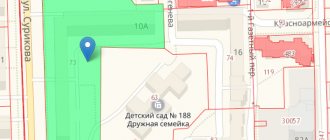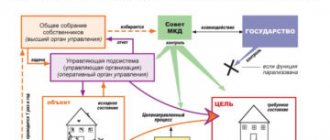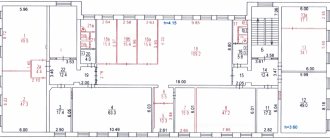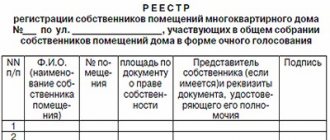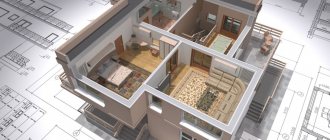Purpose of residential premises in the dormitory
The Russian Housing Law identifies eight types of premises related to specialized housing. One of these types is dormitories. A dormitory is a building, a house, built for temporary residence, or adapted for use by citizens during the period of their official and professional duties, as well as undergoing vocational training.
With the expiration of the specified period, the rental agreement for residential premises in the hostel ceases to be valid; as a general rule, the person’s right to use the housing disappears. The procedure for terminating legal relations between the parties regarding placement in a dormitory is regulated by Art. 105 of the Housing Code of the Russian Federation, it states that the grounds for termination of the contract are completion of studies, termination of performance of professional and official duties.
Only those persons who have an employment or official relationship with the enterprise or institution that provides housing, or are studying in these organizations, can legally live in a dormitory. Based on the analysis of current legislation, residential premises in dormitories are intended exclusively for the residence of these categories of persons; other citizens are not accommodated in dormitories.
Registration norm of living space per person
The social norm is the norm that is required when calculating utility bills. It is different in each region. In general, it is 18 m2, but more often it is increased depending on how many citizens simultaneously live in the apartment and what gender they are.
We invite you to read: Statute of limitations for tax deductions in 2019
The concepts of these terms are given in Article 50 of the Russian Housing Code.
The provision norm is considered to be the smallest number of residential meters for calculating the total area of the premises that will be provided to the family under a social lease agreement.
Most regions take 18 square meters as a basis. m. area, they are used as the provision norm. This size is minimal and can be increased in some cases:
- a room or an apartment with one room is provided;
- housing is transferred to a person with chronic serious illnesses.
The standards are also increasing for employees of internal affairs bodies with the rank of at least colonel, as well as for persons with an academic degree. However, the increased rate cannot ultimately amount to more than two established values.
The accounting standard is considered to be the minimum living space that is accepted to recognize a family as in need of improved housing conditions. Citizens whose premises are less than this value have the right to take the appropriate queue. This applies only to those citizens or families who are recognized as low-income.
It should be clarified that the calculation of need includes all persons who are registered in the premises permanently and temporarily. But it is impossible to register an unlimited number of people in one living space for the purpose of recognizing a family in need of improved living conditions. The authorized bodies will not allow this to be done. Most often, a lack of square meters occurs with the appearance of children in the family, who by law must be registered with the mother.
The authorities of each region independently determine the accounting standard for living space, but it cannot be lower than the provision standards.
Housing standards are applicable when providing housing to a number of categories of citizens who are vulnerable and in need of state assistance.
1. Orphans and children without parental care. This category of living space is entitled to:
- upon completion of stay in specialized institutions, as well as upon completion of the period of stay under guardianship or in foster families;
- after completing conscription service;
- upon expiration of the period of stay in places of deprivation of liberty.
The size of the transferred housing under a social tenancy agreement is subject to regional standards, but may be higher than them. The contract is concluded for five years, and then transferred to personal use. Orphans are necessarily allocated separate housing, which is a comfortable apartment or house.
2. IDPs from housing recognized as dilapidated and unsafe. Most often, such residents are relocated to municipal flexible housing, dormitories. Here the established standards must be observed. Although the new area may be smaller from which the resettlement takes place. In the case of privatization of emergency housing, the same number of meters that were owned is offered in return.
3. Relocation from houses subject to demolition. The seizure of such apartments is subject to the following conditions:
- new housing is provided upon concluding a social rental agreement;
- the new premises must be well-equipped and in the same settlement;
- the area of the new housing is comparable or larger than the old housing.
Moreover, if the premises from which the eviction takes place is less than the established standards, the family can apply for improved living conditions.
4. Military personnel. This category of citizens has the right to receive housing from the state. Here established standards are applied, depending on the composition of the family. Each family member should have 18 square meters. m of living space, and for a single serviceman the room should be 18-25 square meters.
Let's list what housing standards in square meters per person will be in effect in the regions in 2021.
| Region | Minimum number of sq.m. for one person | |
| Accounting norm sq.m. per person | Norm for provision of sq.m. per person | |
| Moscow and Moscow region | 10 | 18 |
| Leningrad region (St. Petersburg) | 9 sq.m. (in separate apartments and houses); 15 sq.m (in communal apartments). | — |
| Perm region | 12 | 15 |
| Yaroslavl region | 12 | 17 |
| Omsk region | 15 | 18 |
| Ekaterinburg | 10 | 16 |
| Rostov region | 6-10 | 18 |
| Krasnodar | 10 | 18 |
| Nizhny Novgorod and Nizhny Novgorod region | 10 sq. m. (in separate apartments and houses); 12 sq.m. (in communal apartments). | 13 |
| Volgograd | 11 | 12-18 |
| Krasnoyarsk, Stavropol | 12 | 15 sq. m for each family member; 18 sq. m - living alone. |
| Kurgan region, Petropavlovsk-Kamchatsky | 13 | 15 |
| Novosibirsk | 12 | 15 |
| Saratov | 10 sq.m. | Family from:
Living alone - 30 sq. m. |
| Samara | 11 sq. m. (in separate apartments and houses); 13 sq.m. (in communal apartments). | Family of 2 or more people. - 14 sq. m. Living alone - 26 sq. m. |
| Ufa (Republic of Bashkortostan) | 12 | 14 |
As can be seen from the data presented, the minimum indicators of housing standards for provision are almost the same in the regions of Russia. It should be borne in mind that this is the lowest limit of indicators, which may increase depending on the circumstances. But less than its norms cannot be applied.
The size of the accounting norm is also left to the discretion of local authorities. The only condition set by federal legislation is that the accounting norm cannot be greater than the provision norm. This is logical: otherwise, a citizen who has just moved into a new apartment would automatically find himself in need of housing.
As of 2015, this norm in Moscow is 10 square meters. m per person (for comparison: the social norm in the capital is 12 sq. m).
Provision of living quarters in dormitories
Any citizen can obtain a place to live if he is in a workplace, training or service that provides housing for use for the period of study or performance of duties, and does not have a place to live in the given area. The relationship between the landlord of the premises and the person to whom the premises are temporarily provided is formalized by a rental agreement.
By decision of the organization providing housing in the hostel, a rule may be established for priority receipt of a room for certain categories of persons. For example, an educational institution, guided by its internal decision, can provide housing, first of all, to students who are winners of Olympiads and prize-winners of competitions.
Residential premises in dormitories are provided at the rate of 6 meters of living space or more for each resident, such rules are established by Article 105 of the Housing Code of the Russian Federation. Allocating a smaller area for use is a violation of the law. Citizens who are officially married can apply for an isolated, separate premises.
SanPiN N 42-121-4719-88
Note. Garbage collection chambers must be provided with convenient access for transport and means of small-scale mechanization. If there is a hot water supply in the building, taps for hot and cold water must be installed in the cells. The garbage collection chamber and the garbage chute shaft must be provided with natural exhaust ventilation through the garbage chute shaft.
2.6. The territory of the dormitories must be maintained in accordance with the rules for the sanitary maintenance of territories of populated areas approved by the Ministry of Health of the USSR, systematically cleaned, watered with water to prevent dust formation, and, if necessary, ice control must be carried out.
3.10. The premises of the medical center, isolation ward, and canteen should be located on the 1st floor. It is advisable to place premises for cultural events, consumer services and administrative ones on the 1st - 2nd floors with maximum isolation from residential premises. Student study rooms should be located separately from rooms that are sources of noise.
Rooms for sports activities should be located on the 1st or basement floors. Gyms are located in separate buildings. In the basement floors it is allowed to place common laundry rooms, showers, storage rooms for storing household equipment and dirty linen, rooms for drying clothes and shoes, technical and other utility rooms.
3.7. Living rooms should be impenetrable, with access to the corridor directly or through the hallway. Dormitory rooms of vocational schools and secondary specialized educational institutions must be directly connected to the corridor. Doors to living rooms must open inward and have sealing gaskets in the doorways. The width of living rooms must be at least 2.2 m.
Requirements for dormitory premises
Dormitory premises must be equipped with pieces of furniture without which living is impossible. It is unacceptable for citizens to live in premises that are not supplied with water, electricity, heating and other systems necessary for people’s use. The premises in question must comply with sanitary, fire, and technical safety requirements.
The dormitory building and the territory of its internal premises must be arranged in such a way as to prevent the risk of injury to persons in the process of using the premises, its systems and equipment. It is prohibited to use emergency buildings or basements as hostels. The organization that provides the hostel may establish rules of conduct and internal regulations, provided that these rules comply with legal requirements. The said normative act defines:
- procedure for providing housing;
- the procedure for access to the premises for persons living in it and strangers;
- rights and obligations of persons living in the hostel;
- rights and obligations of the hostel administration;
- the procedure for eviction of citizens from the hostel;
- liability for violation of the rules of use of the hostel.
It is worth noting that violation of the rules of residence may provoke the eviction of a person from the hostel.
Author of the article
What is the standard living area per person in a dormitory and what regulations regulate this?
I work on a rotational basis in the Far North. Accommodation is organized in a dormitory. Currently, the area per resident is approximately 6.5 - 7 square meters. m. The administration has begun to double the number of residents in the rooms. When implementing these actions, the area per resident will be 3 - 3.5 square meters. m.
We recommend reading: What documents are needed to discharge a child?
When moving into a dormitory, the standard for providing living quarters for each person must be met. The provision norm is established by the normative legal act of the municipality on whose territory the specialized residential premises (dormitory) are located.
How to transfer a dormitory to an apartment building
However, it is still recommended to clarify the method of filing an application with the authority itself. It will take a total of 48 days to submit an application, consider it, make a decision by the authorized body and communicate the decision to the applicant himself.
2. The technical conclusion is approved by the head of the territorial administration and issued to the owner in 2 copies, one copy remains in the files of the RMVC. 5. After transferring the hostel to the status of a residential building, the owner has the right to transfer it for maintenance to a state operating enterprise or organization in the manner established by the order of the Governor of St. Petersburg dated January 10, 1997 N 21-r
Step-by-step instructions for converting non-residential premises into residential premises
According to the Housing Code, isolated premises that are suitable for year-round living are considered residential. There are established sanitary standards (they are described in detail in SanPiN 2.1.2.2645-10), which these premises must fully comply with. According to Article 22 of the Housing Code, incomplete compliance with the requirements is also allowed, but on the condition that the premises can be “brought to mind” and re-arranged at any time. Both entire private houses or apartments, as well as their parts, as well as rooms, are considered residential. In some cases, dachas can also be recognized as residential if they are approved as permanent buildings, that is, the same private houses, but only if this is permitted by the conditions of use of the site on which the dacha is built.
We recommend reading: Application for payment of the funded part of the pension to the Pension Fund of the deceased form
The reconstruction of housing can be considered as a separate part of the operation, since in some cases apartments and houses are recognized as residential in the presence of the reconstruction project itself, in others they require this reconstruction to be carried out first. Thus, the applicant is obliged to carry out repairs without deviating from the plan approved by the design organization and agreed with the municipality, and then make all changes to the technical and title documentation, receive an act from the acceptance committee, which includes representatives of the municipality, fire service, Ministry of Emergency Situations and SES. To make things go faster, you can contact intermediaries, realtors or law firms who collect all permits for redevelopment.
My address is not a house or a street
During the years of the USSR, a quarter of the population of our country lived in dormitories. Students and scientists, engineers and workers were settled there. And they did this in a wide variety of, sometimes even exotic, ways. Now those residents of hostels who have survived to this day as residents of such government premises find themselves in the most difficult situation. Former state-owned enterprises and organizations have massively changed their forms of ownership, and their dormitory buildings are trying to empty their dormitories by all available means.
We still have a lot of dorm residents. And in such situations, they have a direct path to the courts, where they defend their rights to a roof over their heads throughout the country. But such a struggle is not always successful. Therefore, the decision of the Supreme Court on a typical communal story is extremely important not only for those citizens who were faced with attempts to throw them out onto the street. The verdict of the most competent judges in the country will be useful for the judges themselves who resolve such disputes. They will be interested to see the logic of the Judicial Collegium for Civil Cases of the Supreme Court.
The case of the hostel residents was heard in the Krasnodar region. There, a man came to court who, with his family, has been living in one of the local hostels since the last century - since 1984. That distant year, he and his household were moved into a dormitory as an employee of the Black Sea experimental oyster farm. Later, the farm was renamed the Scientific and Experimental Marine Biotechnology Center. The family's problems began in 2005. Then this center entered into a rental agreement with the man for living quarters in the houses of the state and municipal housing stock, simply confirming, after changing the name, that he lives in the apartment of his dormitory. And literally two months later, this center, by order of the Federal Property Management Agency, was privatized, turning into a limited liability company, but with the same name. That's what's important. During this procedure, the dormitory building was not included in the privatized property of the organization.
Two years later, the plaintiff approached this biotechnological center with a request to allow him to privatize the apartment. His request was refused.
The territorial department of the Federal Property Management Agency stated that the hostel is considered federal property and belongs to the specialized housing stock. And in the register of federal property it is listed as a hostel. Therefore, the apartment there is not subject to privatization.
At the same time, this department of the Federal Property Management Agency is holding auctions. The competition is won by a certain medical center. And the Federal Property Management Agency, as a lessor, enters into an agreement with this medical center as a tenant of this building. In the lease agreement and in the technical condition report of the building, the dorm miraculously receives the status of non-residential premises. The puzzled residents of the hostel filed their claim in court with the local Federal Property Management Agency. They asked to invalidate the auction and the subsequent lease agreement. The offended department of the Federal Property Management Agency did not recognize such a claim and went on the offensive, filing a counterclaim. The district court made a half-hearted decision. The court declared the auction and the lease agreement invalid. And he refused to recognize the hostel as a residential premises and cancel such registration. The verdict of the regional court was “to reclaim property from someone else’s illegal possession.” In short, throw the family out onto the street.
The Supreme Court began to literally sort out legal issues.
So, the Supreme Court recalled that according to the Housing Code, the so-called specialized housing stock also applies to residential premises. In other words, dormitories. According to Article 109 of this code (which was in force at the time the family moved in), citizens could move into dormitories for the period of work or study. The procedure for providing housing in a hostel was determined by the Council of Ministers of the RSFSR. He issued a special resolution N328 on this matter. It contains paragraph number 10, which states that housing in a dormitory is provided by decision of the administration, trade union, Komsomol committee, institution, organization, educational institution. In general, everyone who is in charge of the hostel. Based on the decision made, a warrant of the established form was issued.
But here’s a closer look: when moving into the dormitory, the issued warrant was required to be handed over to the dormitory administration. The Supreme Court especially emphasized this point specifically for the Krasnodar Regional Court.
The Supreme Court emphasized that the man, after the farm administration decided to move him into the hostel, handed over the warrant to the hostel administration.
And the Supreme Court also wrote - “the absence of a warrant for a citizen to occupy living space when actually moving into an apartment, living in it, fulfilling the duties of a tenant, does not in itself serve as an obstacle to such a person having the right to use residential premises.”
In addition, the Supreme Court considered incorrect the court’s conclusion that the rental agreement between the center and the man was void. The local court said the center did not have the right to act on behalf of the owner. The highest court responded to this - read the materials of the Plenum of the Supreme Court No. 14 of 2009. The Plenum explained that “after March 1, 2005, the basis for concluding a lease agreement for a specific specialized residential premises, giving the right to move in, is the decision of the owner or an authorized person acting on his behalf (the administration of an enterprise or institution).
The Supreme Court recalled that, according to the Housing Code, the transfer of residential premises to non-residential premises and vice versa is the prerogative of only local authorities, and no such decision was made by the authorities.
Is it possible to change the status of the house?
Often, after the addition of additional structures or the demolition of part of the building, the status of the object can be changed (with the consent of all owners of the premises located in the building). The following documents become the basis for applying to local authorities:
- A plan of a residential building containing a technical description of the object, drawn up on the basis of a construction permit and design documentation.
- A plan of a residential building with a technical description of the object and drawn up in strict accordance with the passport of the premises (if the latter was built after the adoption of the Town Planning Code of the Russian Federation).
- A house plan with a description, drawn up in accordance with the declaration and a judicial act recognizing the ownership of an unauthorized construction (if the object was erected in violation of the Town Planning Code).
- A house plan with a technical description, drawn up on the basis of the declaration, if other documents are missing or lost beyond the possibility of recovery.
IMPORTANT
A change in the status of a residential building entails changes in the rights and responsibilities of the owners of the premises, as well as in the way the property is managed.
